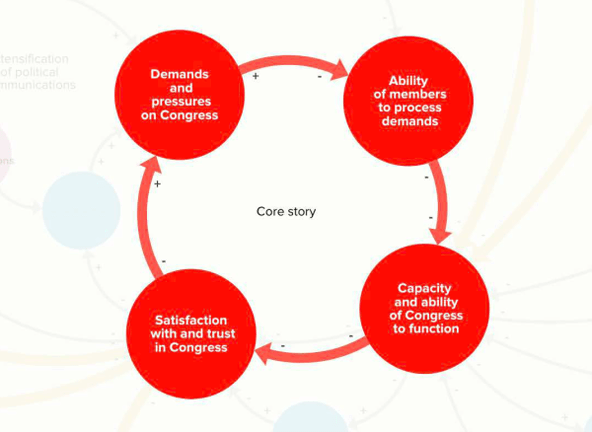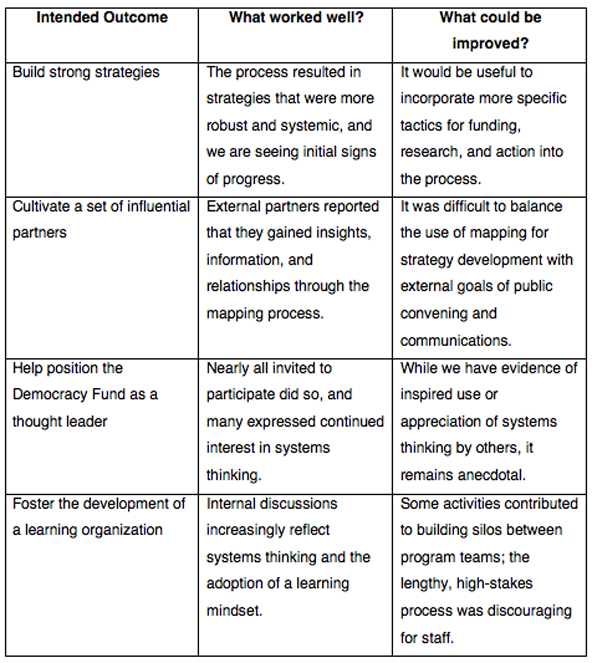In recent years, systems thinking—a discipline that helps us understand interdependent structures of dynamic systems—has emerged as a powerful force for change in the philanthropic world. Borne out of the realization that significant and sustainable social change requires more than discrete interventions, systems thinking has become de rigueur for any foundation looking to create impact at scale. A 2016 publication on systems grantmaking by Grantmakers for Effective Organizations, as well as recent pieces by FSG, Bridgespan, and New Profit have captured this spirit, and sought to provide guidance and direction for foundations navigating this new world.
But what does systems thinking and change look like in the trenches?
The Democracy Fund, which spun off from Omidyar Network as an independent entity in 2014, provides one example. The Democracy Fund’s mission is to help ensure that the US political system can withstand new challenges and deliver on its promise to the American people. Given the complexity of this goal, we knew from the beginning that to produce the greatest impact, we needed to create strong, systems-oriented strategies that aligned with the work of others.
We “drank the Kool-Aid” on systems thinking and chose to pursue a fairly intensive approach to strategy development for three different initiatives. The core approach was causal loop mapping—a structured process of identifying different forces and dynamics in the system. This was followed by a set of activities to identify leverage opportunities (ways we could intervene) in the map, and a strategy development process that built on those opportunities. For instance, based on a causal loop map of Congressional functioning (see below), we identified leverage opportunities around improving the capacity of those who work in Congress (members and staff) and the ways Congress engages with constituents. (See more on our approach and complete maps on two of our initiatives here).
 A causal loop from Democracy Fund’s Congress and Public Trust map depicts the vicious cycle of higher demand, lower capacity, and lower satisfaction. (Image courtesy of Democracy Fund)
A causal loop from Democracy Fund’s Congress and Public Trust map depicts the vicious cycle of higher demand, lower capacity, and lower satisfaction. (Image courtesy of Democracy Fund)
Are you enjoying this article? Read more like this, plus SSIR's full archive of content, when you subscribe.
Evaluating the process
We conducted a two-year process evaluation of these efforts and found that, overall, systems mapping and thinking provided meaningful benefits. Internally, it led to deeper insights, helped develop stronger theories of change, and created a shared language. Externally, it helped develop partnerships and led to a greater understanding of our thought process by grantees. However, systems mapping and the systems-based strategy process we used for our first three initiatives was also time-consuming, complicated, and resource-intensive.
At the start, we believed a systems-based strategy process would:
- Result in more robust strategies than may have emerged from a more traditional planning process
- Help us reach out to and cultivate a set of influential partners
- Help position the Democracy Fund as an innovative thought leader, convener, and funder
- Foster the development of the Democracy Fund as a learning organization
The following chart highlights what worked well and what could work better, based on these four intended outcomes:

Lessons
Here are four lessons based on our findings that may help others pursuing systems-based strategy:
1. Customize the process to the needs of stakeholders.
Though systems thinking can serve a variety of ends—including supporting sense-making and analysis, building new strategies, or communicating with and aligning stakeholders—any given application of the process might prioritize these objectives differently. Hence, it is important to customize the process, and adjust the pacing and sequencing accordingly. A “beginner” group, for instance, may need more orienting to the basic concepts and ideas of systems thinking, where as an “advanced” group could begin deploying tools right away. Organizational maturity is part of that. For new organizations like ours—with a start-up environment, new staff, and lack of infrastructure—the process can take significantly longer.
2. Employ an “ecosystem of tools” that serve different purposes.
Each tool in the “systems thinking toolbox” serves a different purpose; organizations must therefore deploy them with discernment and intentionality. In our case, causal-loop mapping ended up being the primary way we made sense of each system and our role in it. But although the maps helped us identify where we might focus an intervention for greater impact, they did not show us how to engage with the system nor help us identify the value we brought to the space. Other instruments, such as actor mapping, trend analysis, and landscape assessment can and should complement causal loop maps to create a more robust inquiry and stronger strategies.
3. Apply a developmental mindset to the process.
A hallmark of a process like this is that, although there is a sequence of logical steps, there is no expectation that previous steps will be “finished” before moving forward. In fact, downstream activities actually help revisit and clarify upstream ones. In our case, with the Congress map, identifying where to intervene (for example, on Congressional capacity) helped us revisit and explicate the portion of the map that dealt with capacity-related factors. Taking “two steps forward, and one step back” at times can feel frustrating. But acknowledging this dynamic on the front end can actually help alleviate the pressure to get each step in the process “perfect” and ultimately lead to stronger, more thoughtful articulations of a systemic strategy.
4. Recognize that systems thinking is organizational change.
The least acknowledged part of a systems thinking journey like the one we took is that it takes a toll on organizational culture. It can be challenging for staff—especially at an organization that has never gone through the process before—to think and act in a different way. To succeed, organizations need clear, strong leadership committed to shepherding the process and fostering the supportive environment that encourages best thinking. For us, this meant needing to keep an eye on the human experience—helping adult learners nurture curiosity, facilitating difficult conversations among stakeholders, and holding space for staff to work through differences.
Next steps
As we look back at the past couple of years of our evolution as an independent foundation, it is apparent that we have come a long way in our journey as a systems-fluent organization. Betsy Wright Hawkings, who leads our Governance program, carries a copy of the Congress systems map to meetings she has with policymakers on Capitol Hill, and reports of rapt attention to, and enthusiastic agreement about, many of the underlying political dynamics. Tom Glaisyer, who leads our work on media and journalism, has started supporting workshops on systems thinking and adaptive learning for grantee organizations in the journalism space.
In the wake of the 2016 elections, we have begun to build systems-based strategies in three areas: trust in journalism, freedom of the press, and trust in elections. Over the next few months, we will be putting these lessons to instrumental use—implementing a customized approach and using an ecosystem of tools, in a developmental way, while being mindful of our own organizational dynamics. We recognize, however, that our journey continues, and we are eager to continue to learn from our experiences and those of others in the field.
Support SSIR’s coverage of cross-sector solutions to global challenges.
Help us further the reach of innovative ideas. Donate today.
Read more stories by Donata Secondo, Robin Kane & Srik Gopal.

